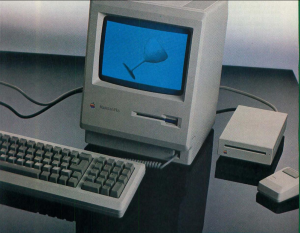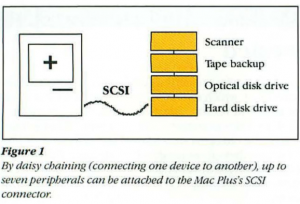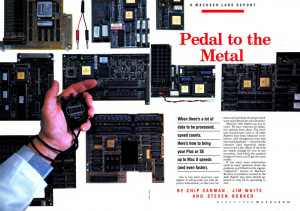I’ve been lucky enough to pick up a few upgrades to my classic Macintosh systems over the years, and in the process of hunting down information on those upgrades I’ve come across ads and reviews of a lot of different options that have been produced over the years for a Macintosh Plus, so I thought I’d create this entry to capture some of what I’ve found, and hopefully people will comment on ones I’ve missed.

1. Baseline Macintosh Plus
I currently have 3, 1MB Macintosh Plus Systems, all upgraded to 4MB, and two upgraded with 4MB Novy Quik 30 (030/25MHz) boards.
- Dates: 1986/01/16 to 1990/10/15, MacWorld April 1986: A change for the plus, article reviewing the new MacPlus in comparison to the 128k and 512k
- Processor: Motorola 68000 running at 8MHz
- Data Path: 16, 8
- Memory: 1MB to 4MB, four 30-pin SIMM slots, 256K or 1MB SIMMs, min speed 150ns, must be installed in groups of two: 512K (2 x 256K), 1MB (4 x 256K), 2.5MB, 4MB. This system cannot use two-chip 1MB SIMMs.
- ROM: 24-bit addressing mode, ID $0075, version $6000, size 128k
- Screen: 512×342 1-bit black and white
- Keyboard: RJ45 connector, the Macintosh Plus was the last Macintosh to use this connector for it’s keyboard before the move to the Apple Desktop Bus (ADB)
- Mouse Port: DB-9 pin, the Macintosh Plus was the last Macintosh to use this connector for it’s mouse before the move to the Apple Desktop Bus (ADB)
- Floppy Size: 3.5″, double sided, standard density, support 400k and 800k disks
- External Floppy port: DB-19
- SCSI 1: DB-25, not fully compliant with SCSI standard, main issue is it does not supply terminator power (if you are using a SCSI2SD adapter you will need to supply power via USB)
- Supported OS: see my entry on Selecting your System Software for your 68k Macintosh
2. CPU / FPU upgrades (may include memory)
Immediately after it’s release in 1986, 3rd party upgrades started getting created for the plus, starting with math co-processors, and maxing out with the release of the Total Systems Gemini Ultra a 68030 processor running at 50MHz. From what I can find there is no 68040 accelerator for the Macintosh Plus, and none that run faster than 50MHz.
I wanted to track down information on my Novy Quik 30 boards, and decided to create this list as I went through back issues of MacUser, MacWorld and upgrade books on the Internet Archive. I’m not sure if someone has done this before, but I couldn’t find a definitive list. I’m also adding links to drivers/enablers, manuals and photos as I find them.
From what I can see, the market for these 68k upgrade boards was pretty much gone by 1995 with the move to the PowerPC chips. Unfortunately that means that a lot of these companies either went bankrupt before websites were common and before the internet archive started scraping sites. If I was able to find something through the way back machine I’ve linked to it.
See my post listing all accelerators and memory addons that I’ve found for 68k Macintosh systems.
3. Memory Upgrades
The Macintosh Plus can be expanded on the motherboard with up to 4MB of memory, there is no way to increase memory available to applications beyond that 4MB limit, but you can make use of addition memory as a Ram Disk.
There were some memory addons created to allow the Macintosh Plus to make use of less expensive chips
See my post listing all accelerators and memory addons that I’ve found for 68k Macintosh systems.
4. Video Upgrades
Soon
5. Networking Upgrades
Soon.
6. Early Storage Addons

I’m not going to capture any of the large, large number of SCSI storage devices that can be used with the Plus, and pretty much any other system that supports SCSI. Instead I’ll only includes storage devices that are truly unique to the Macintosh Plus.
One thing I will mention about the Mac Plus SCSI connector, you may occasionally run in to issues where a device will not work as expected. For example you need to use special settings for a SCSI2SD card to work, and the MacPlus doesn’t provide terminator power, so devices that draw power from the SCSI bus can’t be directly connected to the Plus, e.g. the Asante DeskTop EN/SC SCSI to Ethernet adapter. Also the MacPlus’s SCSI is fairly slow, the original drives used a 3:1 interleave,
Also unlike most systems with SCSI devices, the Plus has a unique boot-up sequence: floppy; SCSI ID 6, 5, 4, 3, 2, 1, 0., vs. floppy then 0, 1, …

Wow, that’s a lot of useful information right there! Thanks for posting this 🙂